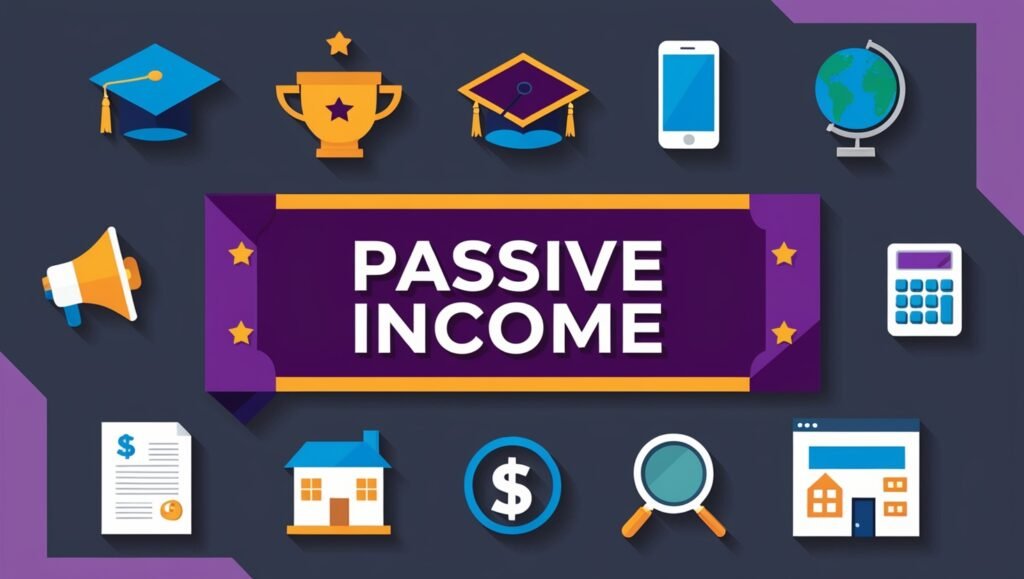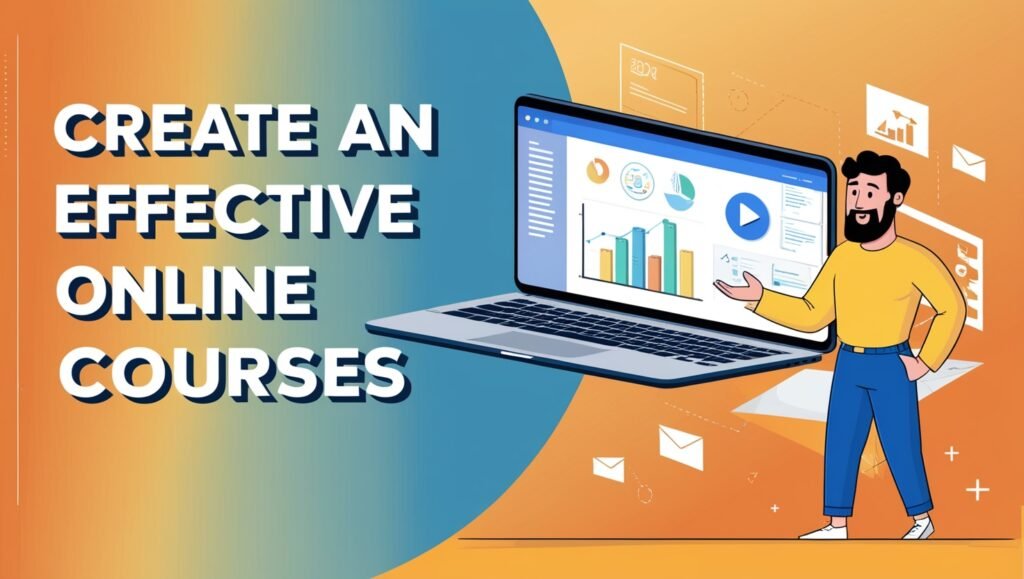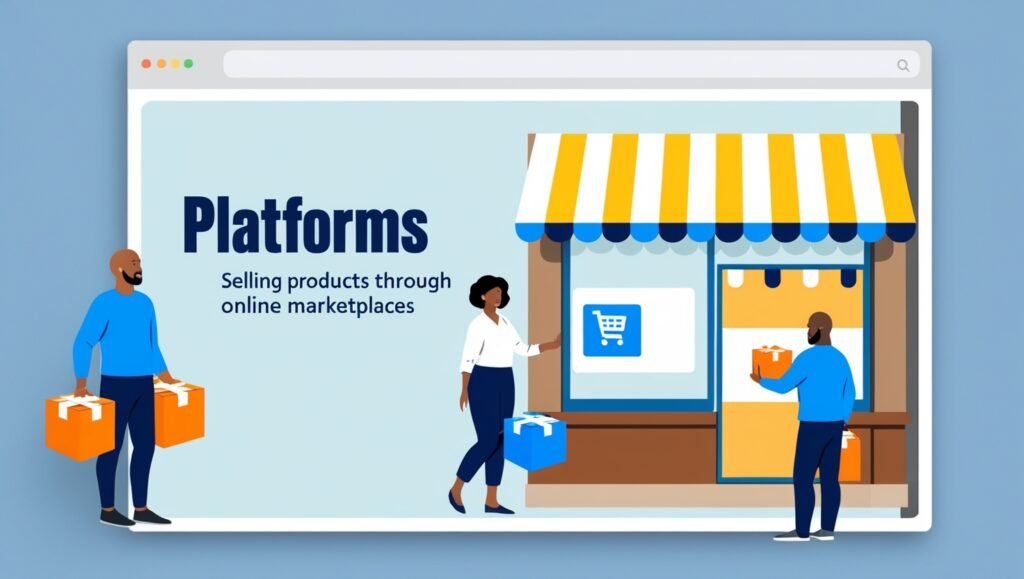
Introduction to Online Income
In today’s digital world, earn money online is easier than ever. You can choose from many options, whether you want to freelance, sell products, or create content. This flexibility allows you to work from home and set your own hours.
If you have skills or interests, you can turn them into income. Many people are already earning a living online, and you can join them. In this article, we will explore different ways for you to make money online. You’ll find tips, tools, and strategies to help you succeed.
Let’s dive in and discover how you can start your online journey today!
Freelancing Opportunities
Freelancing offers many ways for you to earn money online. If you have skills like writing, design, or programming, you can find jobs that fit your talents. Here are some key points about freelancing that can help you get started.
Types of Freelance Work
1. Writing and Editing: If you enjoy writing, you can create articles, blogs, or even books. Many websites need content writers. You can also offer editing services to help others improve their work.
2. Graphic Design: If you are creative, graphic design is a great option. You can create logos, social media graphics, or marketing materials. Many businesses look for freelancers to help them with their designs.
3. Web Development: If you know how to build websites, this skill is in high demand. Companies are always looking for developers to create or improve their online presence.
4. Virtual Assistance: You can offer administrative support to businesses or entrepreneurs. Tasks might include managing emails, scheduling appointments, or organising files.
Finding Freelance Work
You might wonder where to find these freelance jobs. There are several online platforms that connect freelancers with clients:
- Upwork: A popular site where you can create a profile and bid on projects.
- Fiverr: Here, you can list your services and clients can hire you directly.
- Freelancer: This site allows you to compete for jobs by submitting proposals.
Building Your Reputation
When you start freelancing, building a good reputation is crucial. Here are some tips to help you succeed:
- Create a Strong Profile: Make sure your profile highlights your skills and experience. Use a clear photo and write a short bio about yourself.
- Deliver Quality Work: Always do your best on every project. Satisfied clients are likely to leave positive reviews and recommend you to others.
- Communicate Well: Keep in touch with your clients. Respond to messages promptly and clarify any questions they have.
the freedom to choose the work you enjoy. You can set your own schedule and work from anywhere. If you put in the effort, you can build a successful freelance career.
Selling Products and Services

Selling products and services online is a great way to make money. With the right approach, you can reach customers around the world. Here’s how you can get started.
Starting an Online Store
1. Choose Your Products: Decide what you want to sell. This could be physical items, like clothing or crafts, or digital products, such as eBooks or courses. Think about what you are passionate about and what people need.
2. Select a Platform: You’ll need a place to sell your products. Here are a few popular options:
- Shopify: A user-friendly platform that helps you set up an online store quickly.
- Etsy: Great for handmade or unique items.
- Amazon: A large marketplace where you can reach many customers.
3. Set Up Your Store: Create a professional-looking website or store page. Use high-quality images and write clear descriptions of your products. Make sure to set fair prices.
4. Payment and Shipping: Choose how you will accept payments (credit cards, PayPal, etc.) and how you will ship products. Consider offering free shipping to attract more customers.
Selling Digital Products
If you prefer to sell digital items, there are many options:
1. eBooks: If you are knowledgeable about a specific topic, write and sell an eBook. You can sell it on your own site or through platforms like Amazon Kindle.
2. Online Courses: Use your expertise to teach others. Create an online course and sell it on platforms like Udemy or Teachable. Make engaging videos and include helpful resources.
3. Print-on-Demand: You can design products like T-shirts, mugs, or posters without holding any inventory. Websites like Printful allow you to create designs, and they handle printing and shipping.
Marketing Your Products
Once your store is set up, you need to attract customers. Here are some effective marketing strategies:
1. Social Media: Use platforms like Instagram and Facebook to showcase your products. Share engaging content and connect with your audience.
2. Email Marketing: Build an email list of interested customers. Send them updates about new products, sales, and promotions.
3. Search Engine Optimization (SEO): Optimise your product listings with relevant keywords so people can find you on search engines.
online offers flexibility and potential for income. You can turn your ideas into a thriving business. With the right approach and dedication, you can succeed in the online marketplace.
Leveraging Content Creation

Creating content is a powerful way to make money online. If you enjoy writing, recording, or producing, you can turn your passion into profit. Here’s how to get started with content creation.
Blogging
1. Starting a Blog: Choose a topic you love and know about. This could be anything from cooking to travel to personal finance. Use a platform like WordPress or Blogger to set up your blog.
2. Monetization Strategies:
- Affiliate Marketing: Promote products related to your blog’s topic. When someone buys through your link, you earn a commission.
- Advertising: Use services like Google AdSense to display ads on your blog. You earn money every time someone clicks on an ad.
- Sponsored Posts: Collaborate with brands to write articles featuring their products or services for a fee.
3. Growing Your Audience: Share your blog posts on social media to attract readers. Engage with your audience by responding to comments and emails. Consistency is key, so post regularly.
Starting a YouTube Channel
1. Choosing Your Niche: Pick a subject you’re passionate about. This could be tutorials, vlogs, reviews, or entertainment. Find what excites you and can attract viewers.
2. Creating Content: Invest in a good camera and microphone. Plan your videos to keep them engaging and informative. Edit your videos to make them polished and professional.
3. Monetizing Your Channel:
- YouTube Partner Program: Once you meet the requirements, you can earn money from ads shown on your videos.
- Sponsorships: Brands may pay you to promote their products in your videos.
- Merchandise: Create and sell your own branded products to your audience.
Podcasting
1. Starting a Podcast: If you prefer speaking, consider starting a podcast. Choose a theme that interests you and plan your episodes. Use platforms like Anchor to record and distribute your podcast.
2. Building an Audience: Share your episodes on social media and ask listeners to subscribe. Engage with your audience by responding to their feedback and questions.
3. Monetization Options:
- Sponsorships: Collaborate with companies to include ads in your episodes.
- Listener Donations: Platforms like Patreon allow your audience to support you financially.
- Selling Merchandise: Create branded items related to your podcast.
Leveraging content creation can be a fulfilling way to make money online. Whether you choose to blog, create videos, or start a podcast, there are many opportunities available. By focusing on your passion and engaging with your audience, you can build a successful online presence and generate income.
Online Tutoring and Teaching

Online tutoring and teaching are excellent ways to make money while sharing your knowledge. If you have expertise in a subject or skill, you can help others learn and succeed. Here’s how to get started with online education.
Choosing Your Subject
1. Identify Your Strengths: Think about what subjects or skills you excel in. This could be academic subjects like maths or science, languages, or practical skills like music or coding. Choose something you enjoy teaching.
2. Target Your Audience: Decide who you want to teach. Are you focusing on school students, college students, or adults looking to learn new skills? Knowing your audience will help you tailor your lessons.
Platforms for Online Tutoring
1. Tutor Websites: There are several platforms where you can offer your tutoring services:
- VIPKid: Teach English to children in other countries.
- Wyzant: Connect with students looking for help in various subjects.
- Chegg Tutors: Provide assistance in subjects ranging from maths to science.
2. Creating Your Own Website: If you prefer more control, consider building your own website. This way, you can set your rates, schedule, and marketing strategies.
Developing Online Courses
1. Course Creation: If you want to teach a broader audience, consider creating an online course. Identify a topic that people want to learn about and structure your course around it.
2. Course Platforms: Use platforms like:
- Udemy: Create and sell courses on various subjects.
- Teachable: Build your own course website with customizable options.
- Skillshare: Share your skills through engaging video lessons.
3. Engaging Content: Make your course interactive. Include videos, quizzes, and downloadable resources to enhance the learning experience. Clear explanations and practical examples help students understand better.
Marketing Your Tutoring Services
1. Social Media: Use platforms like Facebook, Instagram, and LinkedIn to promote your services. Share tips, success stories, and valuable content related to your teaching subject.
2. Networking: Connect with other educators and professionals in your field. Join online communities or forums where you can share your expertise and attract potential students.
3. Word of Mouth: Encourage your current students to refer you to others. Positive reviews and testimonials can greatly boost your credibility and attract new clients.
Setting Your Rates
1. Research Market Rates: Check what other tutors or course creators charge for similar services. This will help you set competitive rates.
2. Offer Discounts: Consider offering introductory rates or discounts for package deals. This can attract more students and encourage them to sign up.
Online tutoring and teaching allow you to share your knowledge while earning money. With the right approach and dedication, you can build a successful teaching business online. Whether you choose one-on-one tutoring or create an engaging online course, there are countless opportunities to help others while earning income.
Market Research and Surveys

Participating in market research and surveys is a simple way for you to earn money online. Many companies value consumer opinions and are willing to pay for your feedback. Here’s how you can get started.
Understanding Market Research
1. What is Market Research?: Market research involves gathering information about consumer preferences, buying habits, and opinions. Companies use this data to improve their products and services.
2. Why Your Opinion Matters: Your feedback helps businesses understand what customers want. By sharing your thoughts, you can influence product development and marketing strategies.
Taking Online Surveys
1. Finding Survey Websites: There are many platforms where you can sign up to take surveys. Here are some popular options:
- Survey Junkie: This site pays you for completing surveys and sharing your opinions.
- Swagbucks: Earn points for taking surveys, watching videos, and shopping online, which you can redeem for gift cards or cash.
- InboxDollars: Get paid for taking surveys, reading emails, and playing games.
2. Signing Up: Create an account on your chosen survey sites. Be honest when filling out your profile, as this helps match you with surveys that fit your demographics.
3. Completing Surveys: Once you receive survey invitations, complete them promptly. Each survey usually takes 10 to 30 minutes. The more surveys you complete, the more you can earn.
Usability Testing
1. What is Usability Testing?: Usability testing involves evaluating websites or apps to ensure they are user-friendly. Companies want to know how real users interact with their products.
2. Joining Usability Testing Platforms: Sign up for sites like:
- UserTesting: Get paid to test websites and provide feedback on your experience.
- TryMyUI: Share your thoughts while navigating different websites. You earn money for each test you complete.
3. Conducting Tests: Follow the instructions given for each test. You may need to speak your thoughts aloud as you navigate the site. This feedback is valuable to businesses.
Tips for Success
1. Stay Organized: Keep track of the surveys you complete and the payments you receive. Some sites offer points that can be redeemed later, so monitor your progress.
2. Choose Your Time Wisely: Set aside specific times during the week to complete surveys and tests. This will help you stay consistent and maximise your earnings.
3. Be Cautious: While many legitimate sites exist, watch out for scams. Avoid any platform that asks for personal information, such as your Social Security number, or requires payment to join.
Participating in market research and surveys is a flexible way to earn money online. With a little effort and consistency, you can turn your opinions into income. This method allows you to contribute to product development while making extra cash in your spare time.
Passive Income Streams

Creating passive income streams is a smart way to make money online without constantly trading your time for cash. Once set up, these income sources can generate revenue with minimal ongoing effort. Here are some effective methods to establish passive income online.
Affiliate Marketing
1. What is Affiliate Marketing?: Affiliate marketing involves promoting products or services and earning a commission for every sale made through your referral link. It’s a popular way to earn money without having to create your own products.
2. Choosing a Niche: Pick a niche you’re passionate about. This could be anything from health and wellness to technology. Focusing on a specific area helps attract a targeted audience.
3. Joining Affiliate Programs: Sign up for affiliate programs related to your niche. Some popular options include:
- Amazon Associates: Promote millions of products and earn a commission on each sale.
- ShareASale: Connect with various companies and promote their products.
- ClickBank: Focus on digital products like eBooks and online courses.
4. Promoting Products: You can promote affiliate products through:
- Blog Posts: Write reviews or how-to articles that include your affiliate links.
- Social Media: Share your affiliate links on platforms like Instagram, Facebook, or Twitter.
- Email Newsletters: Build an email list and share valuable content along with your affiliate offers.
Selling Digital Products
1. Creating Digital Products: If you have expertise in a certain area, consider creating digital products. Options include:
- eBooks: Write a comprehensive guide or a story and sell it on platforms like Amazon Kindle.
- Online Courses: Develop a course on a subject you know well and sell it on sites like Udemy or Teachable.
- Printables: Create templates, planners, or worksheets that customers can download and use.
2. Setting Up an Online Store: Use platforms like Etsy or your own website to sell your digital products. Make sure to use high-quality images and clear descriptions to attract buyers.
3. Marketing Your Products: Promote your digital products through:
- Social Media: Share your products on platforms like Pinterest and Instagram, where visuals matter.
- Content Marketing: Write blog posts or create videos related to your products, linking to your sales pages.
Creating a Blog or YouTube Channel
1. Monetizing Your Content: If you enjoy writing or creating videos, you can turn your blog or YouTube channel into a passive income source. Once you build an audience, you can earn money through:
- Ad Revenue: Join ad networks like Google AdSense for your blog or YouTube Partner Program for your channel.
- Sponsored Content: Work with brands to create sponsored posts or videos, which can be a lucrative source of income.
2. Building an Audience: Focus on creating valuable, engaging content that attracts followers. The more traffic you have, the more opportunities for monetization.
Investing in Income-Generating Assets
1. Stocks and Dividends: Consider investing in stocks that pay dividends. This way, you can earn money regularly without actively managing the investment.
2. Real Estate Crowdfunding: Platforms like Fundrise allow you to invest in real estate projects. You can earn rental income or profit from property appreciation.
3. Peer-to-Peer Lending: Websites like LendingClub let you lend money to individuals or small businesses. You earn interest on the loans, creating a passive income stream.
Building passive income streams takes time and effort upfront, but the rewards can be significant. By exploring options like affiliate marketing, digital products, and content creation, you can set yourself up for long-term financial success. With the right strategies, you can create a sustainable income source that works for you, even when you’re not actively working.
Investing in Stocks and Cryptocurrency

Investing in stocks and cryptocurrency can be a profitable way to make money online. While both options carry risks, they also offer opportunities for substantial returns. Here’s how to get started with investing in these markets.
Understanding Stocks
1. What are Stocks?: Stocks represent ownership in a company. When you buy shares, you become a partial owner and can benefit from the company’s growth and profits.
2. Types of Stocks:
- Common Stocks: These give you voting rights in the company and the potential for dividends.
- Preferred Stocks: These usually do not have voting rights but may offer fixed dividends.
3. Choosing a Brokerage: To start investing, you need to open a brokerage account. Some popular platforms include:
- Robinhood: Offers commission-free trading and is user-friendly for beginners.
- E*TRADE: Provides a variety of tools and resources for investors.
- Fidelity: Known for excellent customer service and a wide range of investment options.
4. Researching Stocks: Before buying, research potential investments. Look at:
- Company Performance: Review earnings reports, growth potential, and industry position.
- Market Trends: Stay informed about market conditions and economic factors that can affect stock prices.
5. Long-Term vs. Short-Term Investing: Decide if you want to invest for the long term (holding stocks for years) or short-term (buying and selling stocks quickly). Long-term investing often requires less stress and is generally more stable.
Getting Started with Cryptocurrency
1. What is Cryptocurrency?: Cryptocurrency is a digital or virtual currency that uses cryptography for security. Bitcoin is the most well-known example, but there are thousands of others, like Ethereum and Litecoin.
2. Choosing a Cryptocurrency Exchange: To buy and trade cryptocurrencies, you’ll need to sign up for an exchange. Some popular choices include:
- Coinbase: User-friendly and ideal for beginners.
- Binance: Offers a wide variety of cryptocurrencies and trading options.
- Kraken: Known for security and a solid selection of coins.
3. Researching Cryptocurrencies: Similar to stocks, research is crucial. Look at:
- Project Fundamentals: Understand the technology and purpose behind a cryptocurrency.
- Market Trends: Keep track of market movements and news that can impact prices.
4. Investing Strategies: Consider different strategies for investing in cryptocurrency:
- HODLing: This involves buying and holding onto a cryptocurrency for a long time, regardless of price fluctuations.
- Trading: Actively buying and selling based on market trends can be profitable but requires more attention and knowledge.
5. Managing Risk: Cryptocurrency can be highly volatile. Only invest money you can afford to lose, and consider diversifying your portfolio to mitigate risk.
Tips for Successful Investing
1. Educate Yourself: Take the time to learn about the stock market and cryptocurrency. Read books, follow market news, and consider online courses.
2. Start Small: If you’re new to investing, start with a small amount of money. This allows you to gain experience without risking too much.
3. Stay Informed: Keep up with news related to the stock market and cryptocurrency. Changes in the economy or technology can significantly impact your investments.
4. Set Goals: Define your investment goals and time horizon. Knowing what you want to achieve will guide your investment choices.
Investing in stocks and cryptocurrency can be a lucrative way to earn money online. With proper research, education, and risk management, you can build a diversified investment portfolio that generates income over time. Remember, investing requires patience and a willingness to learn, but the potential rewards can be well worth the effort.
Building an Online Portfolio

Creating an online portfolio is essential for showcasing your skills and attracting clients or employers. Whether you’re a writer, designer, developer, or any other professional, an effective portfolio can help you stand out. Here’s how to build a compelling online portfolio.
Choosing the Right Platform
1. Select a Portfolio Website Builder: There are several platforms where you can create your portfolio. Some popular options include:
- Wix: Offers customizable templates and a drag-and-drop interface, making it user-friendly.
- Squarespace: Known for its sleek designs and professional templates.
- WordPress: Highly customizable and ideal for those who want more control over their site.
2. Domain Name: Consider purchasing a custom domain name that reflects your name or brand. A unique domain adds professionalism and makes it easier for clients to find you.
Curating Your Work
1. Showcase Your Best Projects: Select a range of your best work that demonstrates your skills. Include different types of projects to show versatility.
2. Provide Context: For each project, include a brief description that explains your role, the challenges you faced, and the solutions you provided. This helps potential clients understand your thought process and skills.
3. Use High-Quality Visuals: If you’re a designer or artist, use high-resolution images. For writers, include snippets or links to full articles. Make sure your work is presented attractively.
Crafting Your Personal Brand
1. About Me Section: Write a compelling bio that introduces yourself. Share your background, expertise, and what makes you unique. This helps potential clients connect with you on a personal level.
2. Professional Headshot: Use a clear and professional-looking photo. This adds a personal touch and helps build trust with visitors.
3. Contact Information: Make it easy for potential clients to reach you. Include a contact form or your email address, and consider adding links to your social media profiles.
Adding Testimonials and Case Studies
1. Client Testimonials: If you have previous clients, ask for testimonials. Positive feedback builds credibility and can influence new clients to hire you.
2. Case Studies: For significant projects, consider creating detailed case studies. Explain the problem, your solution, and the outcome. This demonstrates your ability to deliver results.
Optimising for Search Engines
1. SEO Basics: Use relevant keywords throughout your portfolio to help it rank higher in search engine results. Think about what potential clients might search for when looking for your services.
2. Mobile-Friendly Design: Ensure your portfolio looks good on all devices. Many people browse on their phones, so a responsive design is essential.
3. Regular Updates: Keep your portfolio up to date with your latest work and achievements. An active portfolio shows that you’re engaged and continuously improving.
Promoting Your Portfolio
1. Social Media: Share your portfolio on platforms like LinkedIn, Instagram, or Twitter. Use hashtags related to your industry to reach a broader audience.
2. Networking: Join online communities or forums related to your field. Engage with others and share your portfolio when appropriate.
3. Freelance Platforms: Consider adding your portfolio to freelance job sites like Upwork or Fiverr. This can help you attract clients looking for your specific skills.
Building an online portfolio is a crucial step for anyone looking to make money online. It showcases your work, establishes your personal brand, and helps you connect with potential clients or employers. By following these steps, you can create a professional and appealing portfolio that highlights your skills and opens doors to new opportunities.
Freelancing and Gig Work

Freelancing and gig work offer flexible opportunities to earn money online. Whether you’re looking for a side hustle or a full-time career, there are many ways to use your skills to find clients and complete projects. Here’s how to get started in freelancing and gig work.
Identifying Your Skills
1. Assess Your Abilities: Take some time to evaluate what skills you have. Are you a great writer, designer, programmer, or marketer? Identifying your strengths will help you determine the type of freelance work you can pursue.
2. Explore Market Demand: Research which skills are in high demand. Websites like Upwork and Fiverr can give you insights into the types of services people are looking for. This can help you tailor your offerings to what clients need.
Finding Freelance Opportunities
1. Freelance Platforms: There are several platforms where you can find freelance jobs. Some popular options include:
- Upwork: A large marketplace for freelancers across various fields, from writing to graphic design.
- Fiverr: Ideal for offering specific services, starting at $5. You can create “gigs” based on your skills.
- Freelancer: Allows you to bid on projects posted by clients looking for freelancers.
2. Job Boards: Look for freelance opportunities on job boards like:
- FlexJobs: Focuses on remote and flexible job listings.
- Remote.co: Lists remote job opportunities across various industries.
- We Work Remotely: Features job postings for remote positions, including freelance roles.
3. Networking: Leverage your existing network. Let friends and family know you’re available for freelance work. Join online communities related to your field to connect with potential clients.
Building Your Brand
1. Create a Professional Profile: On freelance platforms, ensure your profile stands out. Include a professional photo, a strong bio, and detailed descriptions of your skills and experience.
2. Showcase Your Work: Include samples of your work or a portfolio to demonstrate your skills. This can help potential clients assess your capabilities before hiring you.
3. Gather Testimonials: As you complete projects, ask clients for testimonials. Positive feedback can significantly enhance your credibility and attract new clients.
Setting Your Rates
1. Research Market Rates: Look at what other freelancers in your field charge. This will help you set competitive yet fair rates.
2. Choose a Pricing Model: Decide whether you want to charge hourly or per project. Each model has its advantages, so consider what works best for you and your clients.
3. Be Transparent: Clearly communicate your rates to potential clients. If there are additional costs (like revisions or rush fees), make sure to outline those as well.
Managing Your Time
1. Create a Schedule: Set aside specific times for your freelance work. This helps you stay organised and ensures you meet deadlines.
2. Use Project Management Tools: Consider using tools like Trello or Asana to manage your projects and deadlines. These can help you keep track of tasks and stay on schedule.
3. Set Boundaries: Freelancing can sometimes blur the lines between work and personal life. Make sure to establish boundaries to maintain a healthy work-life balance.
Growing Your Freelance Business
1. Continuously Improve Your Skills: Take online courses or attend workshops to enhance your skills. The more knowledgeable you are, the more valuable you become to clients.
2. Expand Your Services: As you gain experience, consider offering additional services. This can attract more clients and increase your income potential.
3. Stay Informed: Keep up with industry trends and changes in the freelance market. Being informed allows you to adapt and stay competitive.
Freelancing and gig work provide an excellent way to make money online while enjoying flexibility and independence. By identifying your skills, finding opportunities, and building your brand, you can create a successful freelance career. With dedication and strategic planning, you can turn your talents into a sustainable income source.
Social Media Management

Social media management is a growing field that allows you to earn money online by helping businesses and individuals manage their online presence. If you enjoy creating content and engaging with audiences, this could be a great opportunity for you. Here’s how to get started in social media management.
Understanding the Role of a Social Media Manager
1. What Does a Social Media Manager Do?: A social media manager is responsible for creating, curating, and managing content across various social media platforms. This includes:
- Developing a content strategy that aligns with the brand’s goals.
- Posting updates and engaging with followers.
- Monitoring analytics to assess the performance of posts and campaigns.
2. Platforms to Focus On: Familiarise yourself with popular social media platforms such as:
- Facebook: Great for community building and engagement.
- Instagram: Ideal for visual content and brand storytelling.
- Twitter: Useful for real-time updates and customer interaction.
- LinkedIn: Perfect for B2B marketing and professional networking.
Building Your Skills
1. Learn About Content Creation: Understanding how to create engaging content is crucial. This includes writing catchy captions, designing graphics, and producing videos.
2. Understand Analytics: Familiarise yourself with analytics tools provided by platforms like Facebook Insights and Instagram Insights. These tools help you measure engagement and adjust your strategies accordingly.
3. Stay Updated on Trends: Social media trends change rapidly. Follow industry leaders, blogs, and social media news outlets to keep your knowledge current.
Finding Clients
1. Freelance Platforms: Start by offering your services on freelance platforms like:
- Upwork: Create a profile highlighting your social media management skills.
- Fiverr: Offer specific services, such as content creation or account management.
2. Local Businesses: Reach out to local businesses that may need help with their social media. Many small businesses don’t have the time or expertise to manage their accounts effectively.
3. Networking: Use your personal and professional networks to find clients. Attend networking events, join relevant online communities, and let people know you offer social media management services.
Creating a Portfolio
1. Showcase Your Work: As you gain experience, build a portfolio that highlights your best social media campaigns. Include case studies that demonstrate your strategies and results.
2. Offer Free Trials: To attract initial clients, consider offering a free trial period. This allows potential clients to see your skills in action without committing to a long-term contract.
3. Gather Testimonials: After completing projects, ask satisfied clients for testimonials. Positive feedback will enhance your credibility and help you attract new clients.
Setting Your Rates
1. Research Market Rates: Look at what other social media managers charge for similar services. This will help you set competitive rates.
2. Choose a Pricing Model: Decide whether you want to charge hourly or on a project basis. You could also consider retainer agreements for ongoing work with clients.
3. Be Transparent: Clearly communicate your rates and what services are included. If there are additional costs (such as for ads or extra content), make sure to outline those as well.
Managing Your Time Effectively
1. Create a Content Calendar: A content calendar helps you plan and organise your posts in advance. This ensures you maintain a consistent posting schedule.
2. Use Scheduling Tools: Tools like Hootsuite or Buffer allow you to schedule posts ahead of time. This saves you time and helps maintain a regular online presence.
3. Monitor Engagement: Regularly check engagement on posts and respond to comments or messages promptly. Active engagement helps build a loyal community around your client’s brand.
Growing Your Business
1. Expand Your Services: As you gain experience, consider offering additional services, such as social media advertising or influencer partnerships. This can increase your income potential.
2. Stay Educated: Take online courses or attend workshops to continuously improve your skills. The more knowledgeable you are, the more valuable you become to clients.
3. Network and Collaborate: Connect with other professionals in the industry. Collaborating with graphic designers or
Creating Online Courses

Creating online courses is a rewarding way to share your knowledge and expertise while making money online. Whether you’re an expert in a specific field or passionate about a hobby, you can design a course that helps others learn. Here’s how to get started with creating online courses.
Identifying Your Course Topic
1. Choose Your Area of Expertise: Think about what skills or knowledge you possess that others might want to learn. This could be anything from digital marketing to cooking to graphic design.
2. Research Market Demand: Before settling on a topic, research what courses are currently popular. Use platforms like Udemy or Coursera to see which subjects attract the most learners.
3. Narrow Your Focus: Instead of a broad topic, consider narrowing it down to a specific niche. For example, instead of “Photography,” you might create a course on “Portrait Photography for Beginners.”
Planning Your Course Content
1. Outline Your Course Structure: Create an outline that breaks your course into manageable modules or sections. This helps you organise your content and ensures a logical flow.
2. Decide on Course Format: Consider how you will deliver your content. Options include:
- Video Lectures: These are engaging and allow you to demonstrate skills visually.
- Written Materials: Supplement videos with written guides, articles, or eBooks.
- Interactive Quizzes: Include quizzes to reinforce learning and keep students engaged.
3. Set Learning Objectives: Clearly define what students will be able to do by the end of your course. This helps guide your content and gives potential students a clear understanding of what they will gain.
Creating Your Course Materials
1. Recording Video Content: If you choose to create video lectures, invest in good recording equipment. A quality microphone and camera can make a significant difference in production quality.
2. Editing Your Videos: Use video editing software to polish your recordings. Programs like Adobe Premiere Pro or iMovie can help you create professional-looking videos.
3. Designing Supplementary Materials: Create worksheets, slides, or downloadable resources that complement your videos. These materials enhance the learning experience and provide additional value.
Choosing a Platform
1. Online Course Platforms: There are several platforms to host and sell your course, including:
- Udemy: A popular platform that allows you to reach a large audience, but they take a percentage of your sales.
- Teachable: Offers more control over pricing and branding, allowing you to create a fully customised course site.
- Skillshare: Ideal for creative courses and offers a subscription model for students.
2. Self-Hosting: If you prefer more control, consider self-hosting your course using WordPress with plugins like LearnDash or LifterLMS. This allows you to build your own website and retain more profit.
Marketing Your Course
1. Build an Email List: Start collecting email addresses from potential students early. Use a lead magnet (like a free mini-course or ebook) to encourage sign-ups.
2. Leverage Social Media: Promote your course on platforms where your target audience spends time. Share valuable content related to your course topic to attract interest.
3. Collaborate with Influencers: Partnering with influencers in your niche can help you reach a wider audience. They can promote your course to their followers, increasing your visibility.
4. Offer Discounts or Early Bird Pricing: Consider offering introductory discounts to encourage sign-ups when you launch your course.
Engaging with Your Students
1. Provide Support: Be available to answer questions and provide feedback throughout the course. This engagement enhances the learning experience and fosters a sense of community.
2. Encourage Interaction: Create a forum or Facebook group for students to interact with each other. This can enhance their learning experience and encourage networking.
3. Request Feedback: After the course, ask students for feedback. This helps you improve future courses and understand what worked well or what needs enhancement.
Continuously Improving Your Course
1. Update Content Regularly: Keep your course materials current by regularly updating them based on industry changes or student feedback.
2. Expand Your Course Offerings: Once you’ve successfully launched one course, consider creating additional courses to complement it. This can help you build a comprehensive learning path for your students.
3. Network and Collaborate: Connect with other course creators. Collaboration can lead to new ideas and expanded opportunities.
Courses are an excellent way to share your expertise while earning money. By carefully planning your course content, selecting the right platform, and effectively marketing your course, you can build a successful online education business. With dedication and creativity, you can empower others to learn while enjoying the benefits of teaching online.
Selling Digital Products

Selling digital products is a fantastic way to generate income online. These products can include anything from eBooks and printables to software and online courses. The key benefit is that digital products often have low overhead costs and can be sold repeatedly without additional effort. Here’s how to get started with selling digital products.
Identifying Your Digital Product
1. Choose a Niche: Think about your interests, skills, and what people might be willing to pay for. Popular niches include:
- Education: eBooks, online courses, and worksheets.
- Creative Arts: Graphic designs, templates, and art prints.
- Health and Fitness: Meal plans, workout guides, and journals.
2. Research Market Demand: Use tools like Google Trends or social media to see what types of digital products are trending. This can help you identify gaps in the market and tailor your offerings.
3. Consider Your Audience: Define who your target audience is. Understanding their needs and preferences will guide the development of your product.
Creating Your Digital Product
1. Plan Your Content: Outline what your digital product will include. If you’re creating an eBook, for example, decide on the chapters and key points you want to cover.
2. Use the Right Tools: Depending on your product type, you might need different tools:
- For eBooks: Use software like Canva or Adobe InDesign to design your book.
- For Printables: Programs like Microsoft Word or Google Docs can help you create documents and templates.
- For Software: If you’re developing an app or software, tools like Visual Studio or programming languages like Python may be needed.
3. Test Your Product: Before launching, consider sharing a draft with friends or a small group of potential users. Their feedback can help you make improvements.
Setting Up Your Online Store
1. Choose a Platform: Decide where you will sell your digital products. Options include:
- Etsy: Great for creative digital products like printables and designs.
- Gumroad: Ideal for selling various digital products directly to consumers.
- Shopify: Offers more control for those looking to create a branded online store.
2. Create Your Product Listings: Write compelling product descriptions that highlight the benefits and features. Use high-quality images to showcase your products effectively.
3. Set Your Pricing: Research what similar products are selling for to determine a competitive price. Consider offering introductory pricing or discounts to attract initial customers.
Marketing Your Digital Products
1. Leverage Social Media: Use platforms like Instagram, Pinterest, and Facebook to promote your products. Share engaging content that showcases how your digital product can solve problems or meet needs.
2. Email Marketing: Build an email list by offering a freebie related to your digital product. Use this list to promote your product launch and share updates.
3. Content Marketing: Start a blog or YouTube channel to provide valuable content related to your product niche. This can help drive traffic to your product pages and establish you as an authority in your field.
4. Collaborate with Influencers: Partner with influencers in your niche to promote your digital products. They can help you reach a wider audience and increase credibility.
Delivering Your Digital Products
1. Automate Delivery: Use platforms that automate the delivery of your digital products. This ensures customers receive their purchases immediately after payment.
2. Create a FAQ Section: Address common questions about your digital products on your website. This can help reduce inquiries and improve customer satisfaction.
3. Provide Support: Be available to assist customers if they encounter issues or have questions about using your products. Good customer service can lead to positive reviews and repeat purchases.
Tracking Your Success
1. Monitor Sales and Analytics: Use analytics tools to track your sales and customer behaviour. Understanding which products are popular can help you refine your offerings.
2. Gather Customer Feedback: Encourage customers to leave reviews or feedback. This can provide valuable insights for improving your products and marketing strategies.
3. Adjust Your Strategy: Based on your sales data and feedback, be prepared to adjust your products, pricing, or marketing strategies. Flexibility is key to ongoing success.
products are a great way to monetize your skills and creativity while enjoying the flexibility of working online. By carefully planning your product, setting up an effective sales platform, and implementing a strong marketing strategy, you can create a successful digital product business. With persistence and innovation, you can turn your ideas into a sustainable income stream.
Affiliate Marketing

Affiliate marketing is a popular way to earn money online by promoting products or services from other companies. As an affiliate, you earn a commission for every sale made through your referral link. This method allows you to generate income without having to create your own products. Here’s how to get started with affiliate marketing.
Understanding Affiliate Marketing
1. How It Works: Affiliate marketing involves three main parties:
- The Merchant: This is the company that sells the product or service.
- The Affiliate: You, the individual promoting the product.
- The Customer: The end user who purchases through your affiliate link.
When a customer clicks on your affiliate link and makes a purchase, you earn a commission.
2. Types of Commissions: Affiliate programs may offer different commission structures:
- Pay-per-sale (PPS): You earn a percentage of the sale.
- Pay-per-click (PPC): You earn a fee for each click on your affiliate link.
- Pay-per-lead (PPL): You earn a commission for each lead generated (e.g., sign-ups).
Choosing the Right Affiliate Program
1. Identify Your Niche: Focus on a specific niche that aligns with your interests and expertise. This makes it easier to promote products authentically and connect with your audience.
2. Research Affiliate Programs: Look for reputable affiliate programs that offer products relevant to your niche. Some popular options include:
- Amazon Associates: A vast selection of products but lower commission rates.
- ShareASale: A wide variety of merchants and products to choose from.
- ClickBank: Focuses on digital products with higher commission rates.
3. Evaluate Commission Rates and Terms: Consider the commission rates, cookie duration (how long you earn commissions after a click), and payment thresholds before joining an affiliate program.
Building Your Platform
1. Create a Website or Blog: Having your own platform allows you to create content around the products you promote. Use a content management system like WordPress to get started.
2. Content Creation: Focus on creating valuable content that resonates with your audience. This can include:
- Product Reviews: Write detailed reviews that highlight the benefits and features of products.
- How-to Guides: Create guides that show how to use the products effectively.
- Comparison Articles: Compare similar products to help your audience make informed decisions.
3. SEO Optimization: Optimise your content for search engines to increase organic traffic. Use relevant keywords, meta tags, and internal links to enhance your visibility.
Promoting Your Affiliate Links
1. Social Media Marketing: Share your content on social media platforms like Instagram, Facebook, and Twitter. Engaging with your audience can drive traffic to your affiliate links.
2. Email Marketing: Build an email list and send newsletters featuring your latest content and affiliate products. This helps you connect with your audience directly and drive sales.
3. Paid Advertising: Consider using paid ads on platforms like Google Ads or Facebook Ads to reach a broader audience. Be sure to target your ads to maximise their effectiveness.
Tracking Your Performance
1. Use Analytics Tools: Most affiliate programs provide tracking tools to monitor your performance. Keep an eye on clicks, conversions, and commissions to understand what works.
2. Analyse Your Content: Determine which types of content drive the most traffic and sales. Use this information to refine your strategies and focus on successful content.
3. Adjust Your Approach: Based on your performance data, be ready to make changes. This could mean shifting your focus to different products, experimenting with new content formats, or adjusting your marketing strategies.
Complying with Regulations
1. Disclose Your Affiliations: It’s important to disclose that you are using affiliate links. This builds trust with your audience and complies with regulations set by the Federal Trade Commission (FTC).
2. Follow Program Guidelines: Each affiliate program has its own rules and guidelines. Make sure to read and follow them to avoid any issues with your account.
Affiliate marketing offers a flexible way to earn money online by promoting products you believe in. By choosing the right programs, creating valuable content, and effectively promoting your affiliate links, you can build a sustainable income stream. With patience and dedication, you can turn affiliate marketing into a successful online venture.
Launching a Podcast

Launching a podcast is an exciting way to share your ideas, connect with an audience, and even earn money online. Whether you’re passionate about storytelling, education, or a specific niche, podcasts allow you to express yourself and build a community. Here’s a step-by-step guide to starting your own podcast.
Defining Your Podcast Concept
1. Choose a Topic: Start by selecting a topic you are passionate about and knowledgeable in. It should also resonate with your target audience. Popular podcast themes include:
- True crime
- Personal finance
- Health and wellness
- Technology and innovation
2. Identify Your Audience: Understand who your ideal listeners are. This will help you tailor your content to meet their interests and needs. Consider factors like age, location, and hobbies.
3. Format and Structure: Decide on the format of your podcast. Common formats include:
- Interview Style: Inviting guests to share their insights.
- Solo Episodes: Sharing your thoughts or expertise alone.
- Panel Discussions: Having multiple hosts or guests discuss a topic.
Planning Your Episodes
1. Create an Episode Outline: Plan the content for your first few episodes. This includes topics, key points, and any guests you might invite. Having an outline keeps you organised and focused.
2. Decide on Episode Length: Consider how long you want each episode to be. Common lengths range from 20 to 60 minutes, depending on your audience’s preferences and the topic.
3. Develop a Publishing Schedule: Consistency is key in podcasting. Choose a schedule that works for you, whether it’s weekly, bi-weekly, or monthly. Stick to it to build listener loyalty.
Recording Your Podcast
1. Gather Equipment: Invest in good quality recording equipment to ensure clear audio. Essential gear includes:
- A decent microphone (USB or XLR).
- Headphones for monitoring sound.
- Audio recording software (such as Audacity or GarageBand).
2. Choose a Recording Space: Find a quiet space with minimal background noise for recording. Consider soundproofing options like carpets or curtains to improve audio quality.
3. Record a Test Episode: Before launching, record a test episode to familiarise yourself with the equipment and editing software. This helps you identify any technical issues.
Editing Your Podcast
1. Edit for Clarity: Use audio editing software to remove mistakes, awkward pauses, or background noise. Focus on creating a polished final product.
2. Add Intro and Outro: Consider adding an introduction and closing segment to each episode. This creates a professional feel and helps establish your podcast brand.
3. Include Music and Sound Effects: Background music and sound effects can enhance your episodes. Make sure to use royalty-free music or licensed tracks to avoid copyright issues.
Hosting and Distributing Your Podcast
1. Choose a Podcast Hosting Platform: Select a reliable podcast hosting service, such as Libsyn, Podbean, or Anchor. These platforms store your episodes and distribute them to major podcast directories.
2. Submit to Directories: Once your podcast is hosted, submit it to popular directories like:
- Apple Podcasts
- Spotify
- Google Podcasts
- Stitcher
3. Create a Podcast Website: Consider building a website to host show notes, episode summaries, and additional resources. This can improve discoverability and provide a space for listener engagement.
Promoting Your Podcast
1. Leverage Social Media: Promote your episodes on social media platforms like Instagram, Twitter, and Facebook. Create engaging visuals and audio snippets to attract listeners.
2. Network with Other Podcasters: Collaborate with other podcasters in your niche. Guest appearances can help you tap into their audience and grow your listener base.
3. Engage with Your Audience: Encourage listener feedback through social media or email. Engaging with your audience builds a community around your podcast.
4. Consider Paid Advertising: If your budget allows, consider using paid advertising on social media or podcast platforms to reach a broader audience.
Monetizing Your Podcast
1. Sponsorships and Advertisements: Once you build a listener base, you can attract sponsors. Reach out to companies that align with your podcast’s niche for potential sponsorship deals.
2. Affiliate Marketing: Promote products or services through affiliate links within your episodes. This can be a source of income if your audience trusts your recommendations.
3. Listener Donations: Consider using platforms like Patreon to allow listeners to support your podcast financially. Offer exclusive content or perks to incentivize donations.
4. Merchandising: Create and sell merchandise related to your podcast, such as branded clothing, mugs, or digital products. This can provide an additional revenue stream.
Launching a podcast can be a fulfilling way to share your voice and connect with others. By carefully planning your content, investing in quality production, and actively promoting your episodes, you can build a successful podcast that resonates with listeners. With dedication and creativity, you can turn your passion into a rewarding online venture.
Selling Products Through Online Marketplaces

Selling products through online marketplaces is an effective way to reach a wide audience without the need for a standalone website. Marketplaces like Amazon, eBay, Etsy, and others provide a platform to showcase your products and handle transactions. Here’s how to get started with selling on these platforms.
Choosing the Right Marketplace
1. Identify Your Niche: Before choosing a marketplace, think about what products you want to sell. Some platforms are better suited for specific types of items:
- Etsy: Great for handmade goods, vintage items, and craft supplies.
- Amazon: Ideal for new products, books, electronics, and household goods.
- eBay: Suitable for used items, collectibles, and auction-style sales.
2. Research Marketplace Fees: Each platform has its own fee structure, including listing fees, commission on sales, and payment processing fees. Make sure to understand these costs to determine your pricing strategy.
3. Evaluate Audience Reach: Consider the size and demographics of each marketplace’s audience. Choose a platform where your target customers are likely to shop.
Setting Up Your Seller Account
1. Create an Account: Sign up for a seller account on your chosen marketplace. This typically involves providing basic information, including your name, email, and payment details.
2. Choose Your Selling Plan: Some marketplaces offer different selling plans. For example, Amazon has an Individual plan (pay-per-sale) and a Professional plan (monthly subscription). Choose the one that aligns with your selling goals.
3. Complete Your Profile: Fill out your seller profile with relevant information, including a bio and a profile picture. A professional profile helps build trust with potential buyers.
Listing Your Products
1. Create Compelling Product Listings: Write clear and engaging product descriptions that highlight the benefits and features of your items. Include important details like dimensions, materials, and usage instructions.
2. Use High-Quality Images: Invest time in taking high-quality photos of your products. Use multiple angles and show the item in use to give potential buyers a better understanding.
3. Optimise for Search: Use relevant keywords in your product titles and descriptions to improve visibility. Research popular search terms related to your product to attract more traffic.
4. Set Competitive Pricing: Research similar products to determine a competitive price point. Consider your costs, fees, and the value of your product when setting prices.
Managing Inventory
1. Track Your Stock: Keep a close eye on your inventory levels. Many marketplaces offer tools to help you manage stock and notify you when items are running low.
2. Restock Wisely: If a product is selling well, be prepared to restock quickly to avoid missing out on sales. Analyse trends to understand which items might need replenishing.
3. Consider Seasonal Trends: Be aware of seasonal demand for certain products. Adjust your inventory accordingly to maximise sales during peak times.
Handling Orders and Customer Service
1. Fulfil Orders Promptly: When you receive an order, ensure you process it quickly. Ship items on time and use reliable shipping methods to maintain customer satisfaction.
2. Communicate with Buyers: Keep customers informed about their orders. Provide tracking information and respond promptly to any inquiries or concerns.
3. Manage Returns and Refunds: Familiarise yourself with the marketplace’s return policies. Handle returns and refunds professionally to maintain a positive reputation.
Marketing Your Products
1. Utilise Social Media: Promote your products on social media platforms like Instagram, Facebook, and Pinterest. Share engaging content that showcases your items and encourages followers to visit your listings.
2. Run Promotions: Take advantage of promotional tools offered by marketplaces, such as discounts, coupons, and flash sales. These can help attract more buyers and increase sales.
3. Encourage Reviews: Ask satisfied customers to leave positive reviews. High ratings and good feedback can significantly boost your credibility and attract new buyers.
4. Participate in Marketplace Programs: Many platforms offer additional programs to help sellers, such as Amazon Prime or Etsy Ads. Consider enrolling in these programs to enhance visibility and sales.
Analysing Performance
1. Use Analytics Tools: Take advantage of the analytics tools provided by the marketplace to track your sales, traffic, and customer behaviour. Understanding these metrics can help you make informed decisions.
2. Adjust Strategies Based on Data: Use the insights gained from analytics to refine your marketing strategies, optimise product listings, and improve customer engagement.
3. Stay Updated with Trends: Regularly research market trends and consumer preferences to stay ahead of the competition. Adapt your product offerings and marketing efforts based on what’s popular.
Selling products through online marketplaces can be a rewarding way to start or grow your business. By choosing the right platform, creating compelling listings, and effectively managing your sales process, you can reach a vast audience and generate income. With dedication and smart strategies, you can build a successful online presence and turn your passion into profit.
Creating and Selling Online Courses

Creating and selling online courses is a great way to share your knowledge and skills while generating income. With the rise of e-learning, many people are eager to learn new things online. If you have expertise in a particular subject, consider creating a course to reach a global audience. Here’s how to get started.
Identifying Your Course Topic
1. Choose a Subject You’re Passionate About: Start by selecting a topic you’re knowledgeable and passionate about. This could be anything from photography, cooking, and digital marketing to personal finance or coding.
2. Research Market Demand: Use tools like Google Trends, social media, and online forums to gauge interest in your topic. Look for gaps in existing courses that you can fill with your unique perspective.
3. Define Your Target Audience: Identify who will benefit from your course. Understanding your audience helps you tailor content that meets their specific needs and interests.
Planning Your Course Content
1. Outline Your Course Structure: Break down your topic into modules or sections. Each module should cover a specific aspect of the subject. This helps organise your content and makes it easier for learners to follow.
2. Create Learning Objectives: Define clear learning outcomes for each module. What should students be able to do by the end of the course? This keeps your content focused and goal-oriented.
3. Decide on Course Format: Choose how you will deliver your content. Options include:
- Video lectures: Engaging and visually appealing.
- Written materials: E-books or PDFs for detailed information.
- Interactive elements: Quizzes, assignments, and discussion forums to enhance learning.
Producing Your Course
1. Record Your Videos: If you choose to create video content, invest in quality recording equipment. Ensure good lighting and sound quality. You can use software like Camtasia or OBS Studio to record and edit your videos.
2. Design Supporting Materials: Create slides, handouts, and additional resources that complement your videos. Visual aids can enhance understanding and retention.
3. Consider Hosting a Live Component: Offering live Q&A sessions or webinars can add value to your course. This interaction allows students to ask questions and get immediate feedback.
Choosing a Platform to Host Your Course
1. Select an Online Course Platform: Choose a platform to host and sell your course. Popular options include:
- Teachable: User-friendly with various customization options.
- Udemy: Large audience but takes a percentage of sales.
- Thinkific: Flexible and offers a free plan to start.
2. Set Up Your Course Page: Create a visually appealing course page with a clear description, course outline, and testimonials if available. Highlight the benefits of taking your course to attract potential students.
3. Pricing Your Course: Determine a fair price based on the value you provide, market rates, and your target audience’s willingness to pay. Consider offering early-bird discounts or bundle deals to encourage sign-ups.
Marketing Your Course
1. Build an Email List: Start collecting email addresses before your course launches. Use a lead magnet, like a free e-book or webinar, to encourage sign-ups. This list will be valuable for promoting your course.
2. Leverage Social Media: Promote your course on platforms where your audience spends time. Share sneak peeks, testimonials, and valuable content related to your course topic to generate interest.
3. Create a Launch Plan: Develop a marketing strategy for your course launch. Consider hosting a webinar, running social media ads, or collaborating with influencers in your niche.
4. Utilise Content Marketing: Write blog posts, create videos, or produce podcasts that provide value related to your course. This positions you as an authority and can drive traffic to your course.
Engaging with Students
1. Provide Ongoing Support: Be available to answer questions and provide assistance to your students. This can be through email, discussion forums, or live sessions.
2. Encourage Feedback: Ask for feedback on your course content and delivery. This will help you improve future courses and build stronger relationships with your students.
3. Foster a Community: Create a community around your course through social media groups or forums. This encourages interaction among students and enhances the learning experience.
Analysing and Improving Your Course
1. Track Course Performance: Use analytics tools provided by your course platform to monitor enrollment, completion rates, and student engagement. This data helps you understand what works and what needs improvement.
2. Iterate and Update Content: Based on feedback and performance metrics, be ready to update your course content regularly. Keeping your material current adds value and retains student interest.
3. Consider Upselling or Creating Advanced Courses: Once you establish your first course, think about creating additional courses that build on the initial material or explore new topics. This can increase your income and provide more value to your audience.
Creating and selling online courses is a rewarding way to share your expertise while generating income. By carefully planning your content, selecting the right platform, and effectively marketing your course, you can reach and impact learners around the world. With dedication and strategic effort, your online course can become a successful source of income.
Becoming an Online Tutor

Becoming an online tutor is a flexible and rewarding way to make money while helping students learn. Whether you excel in academics, music, languages, or any other skill, online tutoring allows you to share your knowledge with a global audience. Here’s how to get started as an online tutor.
Identifying Your Tutoring Niche
1. Assess Your Expertise: Start by identifying subjects or skills you are proficient in. This could include:
- Academic subjects (maths, science, languages)
- Music or art
- Test preparation (SAT, ACT, GRE)
- Specialised skills (coding, public speaking)
2. Research Market Demand: Look into the demand for tutoring in your chosen niche. Platforms like Google Trends or educational forums can help you gauge interest. This will help you identify potential clients.
3. Define Your Target Audience: Consider who would benefit from your tutoring services. Are you targeting elementary school students, high schoolers, or adults looking to learn a new skill? Understanding your audience helps tailor your approach.
Setting Up Your Tutoring Business
1. Choose Your Tutoring Format: Decide how you want to conduct your tutoring sessions. Options include:
- One-on-one sessions via video calls (Zoom, Skype)
- Group classes for a more interactive experience
- Pre-recorded lessons for students to learn at their own pace
2. Create a Tutoring Profile: If you plan to use online tutoring platforms (like Chegg, Tutor.com, or Wyzant), set up a professional profile. Include your qualifications, experience, and teaching style to attract potential students.
3. Set Your Rates: Determine how much you will charge for your services. Research what other tutors in your niche charge and consider factors like your experience and the complexity of the subject.
Preparing Your Tutoring Sessions
1. Develop a Curriculum: Outline what you want to teach in each session. Create lesson plans that align with your students’ goals and learning styles. Include activities, exercises, and assessments to keep students engaged.
2. Gather Resources: Collect materials that will aid your tutoring sessions. This could include textbooks, online resources, worksheets, or educational tools (like quizzes or games).
3. Use Technology Effectively: Familiarise yourself with the tools you’ll use during sessions. Learn how to share screens, use virtual whiteboards, and utilise any software that enhances the learning experience.
Marketing Your Tutoring Services
1. Build an Online Presence: Create a website or social media profiles to promote your tutoring services. Share valuable content related to your niche, such as study tips, educational articles, or free resources.
2. Leverage Online Marketplaces: Join online tutoring platforms where you can list your services. These platforms often have built-in audiences looking for tutors, making it easier to find clients.
3. Network and Get Referrals: Tell friends, family, and colleagues about your tutoring services. Word of mouth can be powerful, especially within local communities or online groups.
4. Offer Free Trials: Consider offering a free introductory session to attract students. This allows potential clients to experience your teaching style and helps build trust.
Engaging with Students
1. Create a Positive Learning Environment: Establish a welcoming and supportive atmosphere. Encourage students to ask questions and express their concerns. Make learning enjoyable and interactive.
2. Personalise Your Approach: Adapt your teaching style to meet the individual needs of each student. Some may require more visual aids, while others might benefit from hands-on practice or discussions.
3. Provide Feedback and Support: Regularly assess your students’ progress and provide constructive feedback. Offer encouragement and support to motivate them and boost their confidence.
Managing Your Tutoring Business
1. Schedule Sessions Efficiently: Use scheduling tools to manage your availability and help students book sessions. Platforms like Calendly or Google Calendar can streamline this process.
2. Track Payments and Invoicing: Keep records of your earnings and expenses. Use accounting software or spreadsheets to track payments and manage your finances.
3. Ask for Reviews and Testimonials: After sessions, request feedback from students and parents. Positive reviews can enhance your reputation and attract new clients.
Continuing Your Development
1. Seek Professional Development: Stay updated with educational trends and techniques. Consider taking courses in pedagogy or specialised training in your subject area.
2. Join Online Communities: Engage with other tutors and educators through online forums or social media groups. Sharing experiences and resources can improve your skills and expand your network.
3. Expand Your Offerings: Once established, consider expanding your services. This could include offering workshops, creating online courses, or tutoring in additional subjects.
Becoming an online tutor is a fulfilling way to share your knowledge and help others succeed. By choosing your niche, effectively marketing your services, and engaging with students, you can create a rewarding online tutoring business. With commitment and a passion for teaching, you
Becoming a Virtual Assistant

Becoming a virtual assistant (VA) is an excellent way to earn money online while providing valuable support to businesses and entrepreneurs. As a VA, you can work from home, choose your clients, and manage your own schedule. Here’s a guide on how to get started in this growing field.
Understanding the Role of a Virtual Assistant
1. What is a Virtual Assistant?
A virtual assistant provides administrative, technical, or creative support to clients remotely. Tasks can vary widely and may include managing emails, scheduling appointments, handling social media, or providing customer support.
2. Identify Your Skills:
Assess your skills and experience to determine what services you can offer. Common skills include:
- Administrative tasks (data entry, organisation)
- Social media management
- Customer service
- Content creation (writing, graphic design)
- Bookkeeping
3. Specialising:
Consider specialising in a particular area to stand out. For example, you could focus on social media management, real estate support, or e-commerce tasks. Specialisation can help you attract clients looking for specific expertise.
Setting Up Your Virtual Assistant Business
1. Choose Your Business Structure:
Decide if you want to operate as a sole proprietor or establish a formal business entity (like an LLC). Research the requirements in your area regarding business licences and tax obligations.
2. Create a Professional Website:
Build a website to showcase your services, skills, and experience. Include a portfolio of your work, client testimonials, and a clear list of services offered. A professional website helps establish credibility.
3. Define Your Services and Pricing:
Clearly outline the services you offer and set your rates. You can charge hourly, per project, or on a retainer basis. Research competitors to determine competitive pricing in your niche.
Finding Clients
1. Utilise Job Boards:
Explore freelance job boards like Upwork, Freelancer, and Fiverr to find clients. These platforms allow you to create a profile, showcase your skills, and bid on projects that match your expertise.
2. Network and Leverage Social Media:
Use social media platforms like LinkedIn, Facebook, and Twitter to connect with potential clients. Join groups related to your niche and participate in discussions to build relationships.
3. Offer Free or Discounted Services Initially:
To gain experience and build your portfolio, consider offering your services at a discounted rate or for free to a few clients. This can help you gather testimonials and demonstrate your capabilities.
4. Ask for Referrals:
Once you have completed a few projects, ask satisfied clients for referrals. Word-of-mouth recommendations can lead to new opportunities.
Managing Your Virtual Assistant Business
1. Stay Organized:
Use tools like Trello, Asana, or Notion to keep track of tasks and deadlines. Organisation is key to managing multiple clients and projects effectively.
2. Set Boundaries:
Establish clear working hours and communicate them to your clients. This helps maintain a work-life balance and sets expectations regarding your availability.
3. Use Time-Tracking Tools:
Tools like Toggl or Clockify can help you track the time spent on each task or project. This is especially important if you bill clients hourly.
4. Communicate Effectively:
Maintain open and clear communication with your clients. Use tools like Slack or Zoom for regular check-ins, updates, and feedback sessions.
Continuing Professional Development
1. Enhance Your Skills:
Continuously seek opportunities to learn and improve your skills. Online courses, webinars, and workshops can help you stay current with industry trends and tools.
2. Stay Updated on Technology:
Familiarise yourself with the latest software and tools that can enhance your efficiency. Being tech-savvy can make you more attractive to potential clients.
3. Join VA Communities:
Connect with other virtual assistants through online forums and communities. Sharing experiences, tips, and resources can provide valuable insights and support.
Building Long-Term Relationships with Clients
1. Deliver High-Quality Work:
Always strive for excellence in your work. Meeting or exceeding client expectations can lead to repeat business and long-term partnerships.
2. Request Feedback:
After completing projects, ask clients for feedback on your performance. Constructive criticism can help you improve and show clients that you value their opinions.
3. Stay in Touch:
Keep in contact with past clients even after projects are completed. Sending occasional check-ins or updates can lead to future opportunities.
Becoming a virtual assistant offers a flexible way to earn income while leveraging your skills. By understanding the role, effectively marketing your services, and managing your business professionally, you can create a successful career as a VA. With determination and dedication, you can build a rewarding business that fits your lifestyle.






